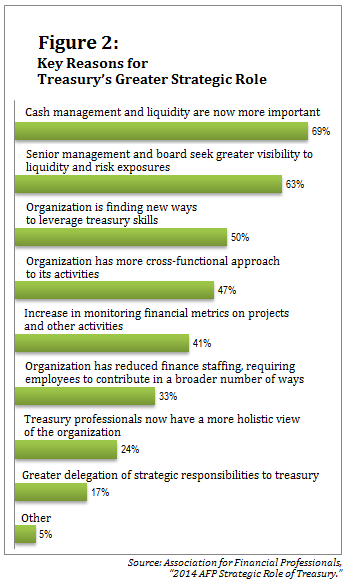When the Association for Financial Professionals (AFP) surveyedcorporate finance professionals in 2011, 81 percent of respondentssaid the treasury function's role had become more strategic overthe past five years. That trend shows no sign of abating. In the“2014 AFP Strategic Role of Treasury” survey report, released todayby the AFP and Oliver Wyman, 84 percent said treasury's role hasexpanded again. And 83 percent expect their treasury team to becomeeven more strategic in the next half-decade.
|The latest survey explored exactly what treasury is doing thesedays, and the answers to those questions—especially among largecompanies—indicate why more and more consider the word “strategic”to apply to the treasury function. The activities in which thelargest proportion of respondents said their treasury functionplays a lead role are fairly predictable: bank relationshipmanagement, borrowing, and investing (see Figure 1, below). Morethan half of treasury teams, and nearly two-thirds of those inlarge organizations, also have lead roles in financial riskmanagement and counterparty risk analysis.
|Treasury is also heading up some efforts that did nottraditionally fall under the function's purview. Twenty-eightpercent of respondents said their treasury team has taken a leadrole in investor relations, 26 percent in mergers and acquisitions,28 percent in business continuity planning, and 12 percent inaccounting and SEC compliance.
|Likewise, when asked to rate the importance of their treasurydepartment to certain corporate activities, 91 percent saidtreasury is “important” or “very important” in their company's cashmanagement; 92 percent said the function is important or veryimportant in banking; and 81 percent said it's important or veryimportant in foreign exchange risk. But nearly a third saidtreasury plays an important (14 percent) or very important (15percent) role in taxes, and nearly as many said treasury has animportant (16 percent) or very important (11 percent) role insupply chain financing.
|In many respects, treasurers in large organizations areexpanding their roles more quickly than those in smaller companies.Sixty-two percent of respondents in companies of every sizeindicated that cash management and forecasting is a key area offocus for their treasury function in the next two years. But thosein larger companies are more likely to also give priority tofinancing and capital allocation (51 percent of respondents inlarge companies, vs. 39 percent in smaller companies); mergers andacquisitions/investment banking (18 percent, vs. 11 percent forsmaller companies); and credit syndicate renewal (14 percent, vs. 8percent for smaller companies).
|
The result of all these trends: Treasurers are considered to beC-level executives in many organizations. Thirty-seven percent ofall respondents said their company's treasurer is a member of theexecutive committee or the C-suite. That number is higher fororganizations with less than $1 billion in annual revenue (43percent) than for organizations with more than $1 billion inrevenue (32 percent). But even treasurers who aren't in the C-suitehave the attention of those who are.
|When asked to rate the treasury team's access and visibility tothe executive committee/C-suite, on a scale of one to five whereone is “poor” and five is “excellent,” nearly three-quarters ofrespondents selected either four or five. And in 55 percent ofcompanies, and 58 percent of public companies, the treasuryfunction formally measures—and communicates to executive managementand the board about—its contribution to company performance.
|The AFP survey also explored the question of why treasurers arebecoming more strategic. The majority of respondents pointed to theincreasing importance of cash management and liquidity toorganizations' senior managers, as well as the fact that seniormanagement and the board are constantly seeking greater visibilityinto liquidity and risk exposures. (See Figure 2, below.)
|As the role of the treasury function continues to shift,companies are using a variety of metrics to gauge its performance.Borrowing costs and banking expenses are both popular choices,cited by 58 percent and 51 percent of AFP survey respondents,respectively. For 55 percent, liquidity targets rank in performancejudgments, and 49 percent of treasurers (54 percent of those inlarge companies) are gauged on the effectiveness of their riskmanagement programs. But within large companies, the most popularof all treasury-performance metrics is capital structure support,selected by 62 percent of respondents from companies over $1billion in revenue but only 29 percent of those in smallerorganizations.
|
Complete your profile to continue reading and get FREE access to Treasury & Risk, part of your ALM digital membership.
Your access to unlimited Treasury & Risk content isn’t changing.
Once you are an ALM digital member, you’ll receive:
- Critical Treasury & Risk information including in-depth analysis of treasury and finance best practices, case studies with corporate innovators, informative newsletters, educational webcasts and videos, and resources from industry leaders.
- Exclusive discounts on ALM and Treasury & Risk events.
- Access to other award-winning ALM websites including PropertyCasualty360.com and Law.com.
*May exclude premium content
Already have an account? Sign In
© 2024 ALM Global, LLC, All Rights Reserved. Request academic re-use from www.copyright.com. All other uses, submit a request to [email protected]. For more information visit Asset & Logo Licensing.







